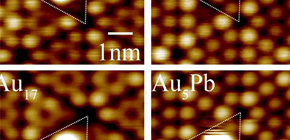
New atomic manipulation technique for assembling nanoclusters
Will likely lead to the development of single-electron devices and nanocatalysts.
A group of researchers discovered a new atomic manipulation technique for assembling nanoclusters at room temperature from individual atoms evaporated onto a surface.
• Graduate School of Engineering, Osaka University -- SUGIMOTO Yoshiaki , Associate Professor,
• Institute of Scientific and Industrial Research, Osaka University -- Ayhan Yurtsever , Specially Appointed Lecturer, MORITA Seizo , Specially Appointed Professor
• Graduate School of Engineering Science, Osaka University -- ABE Masayuki , Professor
This group has demonstrated that it is possible to create nanoclusters possessing the number of constituent atoms and composition desired. That is, it has become possible to examine in detail how the size of a nanocluster and its chemical composition change electronic and chemical properties. This group's method will likely lead to the development of single-electron devices and nanocatalysts.
Abstract
Nanoclusters supported on substrates are of great importance in physics and chemistry as well as in technical applications, such as single-electron transistors and nanocatalysts. The properties of nanoclusters differ significantly from those of either the constituent atoms or the bulk solid, and are highly sensitive to size and chemical composition. Here we propose a novel atom gating technique to assemble various atom clusters composed of a defined number of atoms at room temperature. The present gating operation is based on the transfer of single diffusing atoms among nanospaces governed by gates, which can be opened in response to the chemical interaction force with a scanning probe microscope tip. This method provides an alternative way to create pre-designed atom clusters with different chemical compositions and to evaluate their chemical stabilities, thus enabling investigation into the influence that a single dopant atom incorporated into the host clusters has on a given cluster stability.

Figure 1

Figure 2

Figure 3
To learn more about this research, please view the full research report entitled " Mechanical gate control for atom-by-atom cluster assembly with scanning probe microscopy " at this page of the Nature Communications website.
Related link :
